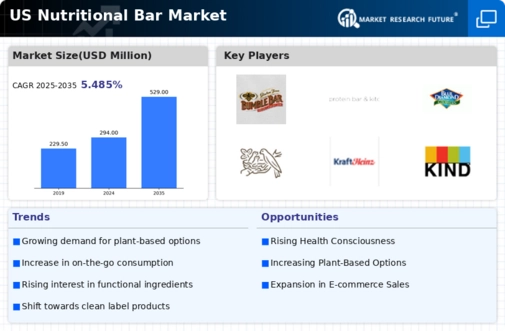Expansion of E-commerce Channels
The nutritional bar market is witnessing a significant shift towards e-commerce as a primary sales channel. With the rise of online shopping, consumers are increasingly purchasing nutritional bars through digital platforms. This trend is particularly relevant in the context of the convenience and variety that online shopping offers. Data shows that e-commerce sales in the nutritional bar market have grown by over 30% in recent years, reflecting a broader shift in consumer behavior. Brands are capitalizing on this trend by enhancing their online presence and offering subscription services, which provide consumers with regular deliveries of their favorite products. This expansion of e-commerce channels not only broadens market reach but also allows for targeted marketing strategies that cater to specific consumer segments.
Innovations in Flavor and Texture
Innovation plays a crucial role in the nutritional bar market, particularly in terms of flavor and texture. As competition intensifies, brands are compelled to differentiate their products through unique taste experiences. This has led to the introduction of a diverse array of flavors, ranging from exotic fruit blends to savory options. Additionally, advancements in food technology are enabling manufacturers to create bars with improved textures, appealing to a wider audience. Market Research Future indicates that consumers are increasingly drawn to bars that offer a satisfying crunch or chewy consistency, enhancing the overall eating experience. This focus on innovation not only attracts new customers but also fosters brand loyalty within the nutritional bar market.
Rising Demand for On-the-Go Nutrition
The nutritional bar market experiences a notable surge in demand for convenient, on-the-go nutrition solutions. As lifestyles become increasingly hectic, consumers seek quick and healthy snack options that fit seamlessly into their daily routines. This trend is particularly pronounced among busy professionals and active individuals who prioritize nutrition without sacrificing convenience. According to recent data, the nutritional bar market has seen a growth rate of approximately 8% annually, driven by this demand for portable nutrition. The industry is adapting by introducing a variety of flavors and formulations that cater to diverse dietary preferences, including vegan and gluten-free options. This shift not only enhances consumer choice but also positions the nutritional bar market as a key player in the broader health and wellness sector.
Growing Interest in Sustainable Ingredients
Sustainability is becoming a pivotal concern for consumers, influencing their choices in the nutritional bar market. There is a marked increase in demand for products that utilize sustainably sourced ingredients, reflecting a broader societal shift towards environmental consciousness. Brands are responding by incorporating organic, non-GMO, and ethically sourced components into their formulations. This trend is supported by data indicating that approximately 60% of consumers are willing to pay a premium for products that align with their values regarding sustainability. As a result, the nutritional bar market is likely to see continued growth in this segment, as companies strive to meet the expectations of environmentally aware consumers.
Increased Awareness of Nutritional Benefits
There is a growing awareness among consumers regarding the nutritional benefits of various ingredients found in nutritional bars. This heightened consciousness is influencing purchasing decisions, as individuals become more discerning about what they consume. The nutritional bar market is responding by incorporating superfoods, protein sources, and functional ingredients that appeal to health-conscious consumers. For instance, bars enriched with plant-based proteins or those containing probiotics are gaining traction. Market data indicates that products highlighting specific health benefits, such as improved digestion or enhanced energy levels, are experiencing increased sales. This trend suggests that the nutritional bar market is evolving to meet the demands of informed consumers who prioritize health and wellness in their dietary choices.























Leave a Comment